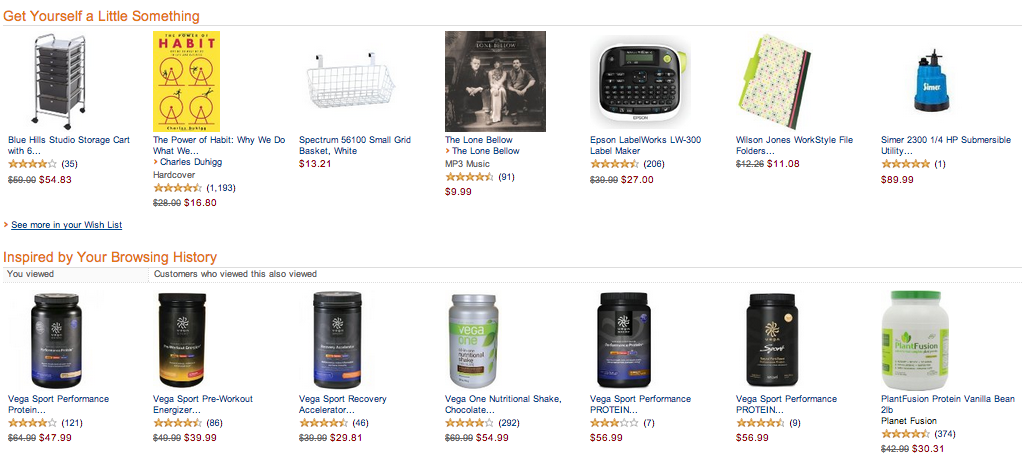Are you familiar with a little website called Amazon? You may have heard of it before. They've taken the world of digital marketing and flipped it on its head. They've set the tone for marketers, worldwide. They've made marketing lovable.
Take a look at anyone's Amazon homepage, and you'll get a glimpse into who they are:
From my Amazon homepage, you can see that I'm an organized workout fanatic. Anyone who knows me can vouch for that.
The Definition of Dynamic Content
The way Amazon is able to truly personalize every touch they have with their customers and prospects isn't magic, it's dynamic content. So, what is "dynamic content"? Also known as "smart" or "adaptive" content, HubSpot defines it pretty stinkin' well: "...a term for the aspects of a website, ad, or email body that change based on the interests or past behavior of the viewer. It creates an experience that's customized specifically for the visitor or reader at that moment."
Whoa.
This is the type of technology that gets me all sorts of geeked out.
The Rise of Dynamic Content
As Inbound Marketers, we talk a lot about content marketing. While content marketing is really important, with changing technology and savvy consumers, context is becoming as equally important.
Dynamic content enables us marketers to deliver on that promise of serving our prospects and customers the right content at the right time.
Really, it's all about making the experience for the prospects and customers better. We're not hitting them over the head with things they don't need. Instead, we're delivering messaging (and ultimately products or services) that are actually useful to them. It's making marketing and sales lovable.
And, with capable marketing software and certified Inbound Marketers at the helm, dynamic content is now accessible to all organizations-- large and small.
How to Use Dynamic Content
With the really innovative organizations (like Amazon and HubSpot), we're already starting to see how they're using dynamic content. But, how can you follow their lead and use dynamic content for your own organization?
- First, you need the proper tools like:
- A contact database that not only contains your customers' and leads' contact information, but also includes information about their behaviors-- What are they doing on your site? What have they downloaded? Do you have their social media information?
- The proper software: This should integrate seamlessly with your contact database. Proper software will display (or hide) content based on rules set by your certified inbound marketers. It'll also integrate other tools like email and social media.
- An easy-to-use Content Management System (CMS): If it's really difficult to make changes to your website content (i.e. you need to be a coding expert to do anything with the site), you need to re-evaulate your current way of doing things. For dynamic content to be used properly, your site has to be one that is easily editable.
- Develop a content personalization strategy: What criteria will determine who sees what content? There are an infinite number of ways you can segment, to ensure that the content is delivered to the right person, at the right time. While software is essential, you'll need to know what you're doing, in order to make the smart content work. On the back-end, your team of doers (as I talked about in this post) will need to get down to business, create rules and workflows to ensure that your content is in context.
- Measure and Improve: Great marketing software will help you do this, but it's worth mentioning again. (I originally talked about it in this post.) You should be measuring (at the very least):
- What companies are visiting your website and see what content brought them in
- How engaged your leads are and what content is drawing them in
- Visit to lead data
- Lead to customer data
- Where your best traffic comes from
- There's a whole heck of a lot more, but for brevity's sake, I'll stop here.
More Marketing Trends (19 to be exact)
Now that you're up-to-speed on Dynamic Content, what else can you expect from the world of marketing? Take a look at our eBook 20 Marketing Trends and Predictions for 2013 and Beyond. In the eBook, we talk about Smart/Dynamic Content. We also delve in to Marketing & Revenue Generation, Integrating Social Media, Mobile Trends, Search Engine Optimization, and more.
Click the image, below, to access the eBook.
Enjoy!









